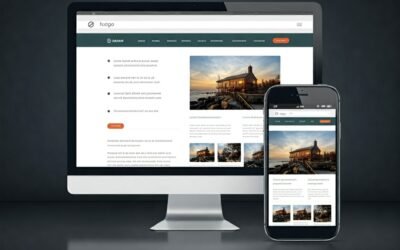2024 E-commerce Web Design Trends: The Ultimate Guide for Business Success
Key Takeaways
- Mobile-first design is non-negotiable, with m-commerce projected to drive 70%+ of online sales
- Minimalist UX principles enhance conversion rates and user engagement
- AI-powered personalisation and chatbots are reshaping customer service
- High-quality visual content remains crucial for product presentations
- Social proof and streamlined checkout processes directly impact sales
Introduction
The digital marketplace is evolving at breakneck speed. For e-commerce entrepreneurs and business owners, staying ahead of web design trends isn’t just about aesthetics—it’s about survival.
According to Shopify’s latest commerce trends report, businesses that adapt to emerging design patterns see significantly higher conversion rates.
Let’s explore the game-changing web design trends that are reshaping e-commerce in 2024.
Mobile Commerce: The New Normal
The statistics are crystal clear. Mobile shopping isn’t just growing—it’s dominating.

Recent data from Statista shows mobile commerce will surpass 70% of all e-commerce transactions.
What does this mean for your business?
- Responsive design is mandatory
- Touch-friendly interfaces are essential
- Loading speeds must be lightning-fast
- Mobile payment options need to be diverse
Embracing Minimalistic Design
Less is more in 2024. The minimalist approach isn’t just trendy—it’s strategic.
Research by Nielsen Norman Group confirms that simplified layouts reduce cognitive load.

Key elements of minimalist e-commerce design include:
- Clean, uncluttered product pages
- Abundant white space
- Clear typography hierarchies
- Focused calls-to-action
- Simplified navigation menus
Visual Content Excellence
High-quality visuals aren’t optional anymore. They’re the backbone of successful e-commerce.
Studies by MDG Advertising reveal that 67% of consumers consider image quality vital in purchasing decisions.
Modern visual content must include:
- 360-degree product views
- Lifestyle photography
- Demonstration videos
- Augmented reality previews
- Zoom functionality
Personalisation: The Future of Shopping
AI-driven personalisation is revolutionising e-commerce. According to Epsilon research, 80% of consumers are more likely to purchase when offered personalised experiences.
Essential personalisation features include:
- Product recommendations based on browsing history
- Customised email marketing
- Personalised landing pages
- Tailored promotional offers
- Dynamic pricing strategies
Streamlining the Checkout Process
Cart abandonment remains a crucial challenge. Baymard Institute’s research shows that simplified checkouts can recover up to 35% of lost sales.
Modern checkout must offer:
- One-click purchasing options
- Guest checkout availability
- Multiple payment methods
- Clear delivery information
- Progress indicators
The Rise of Conversational Commerce
Chatbots and AI assistants are transforming customer service. Gartner predicts that 85% of customer interactions will be handled without human agents by 2025.
Essential chatbot features include:
- 24/7 availability
- Multilingual support
- Product recommendations
- Order tracking
- Instant query resolution
Leveraging Social Proof
Trust signals are more important than ever. BrightLocal’s survey shows that 87% of consumers read online reviews for local businesses.
Effective social proof includes:
- Customer reviews and ratings
- User-generated content
- Trust badges and certifications
- Social media integration
- Celebrity endorsements
Frequently Asked Questions on E-Commerce Web Design Trends
How much should I invest in mobile optimisation?
Allocate at least 30% of your web design budget to mobile optimisation. It’s crucial for future growth.
What’s the ideal number of steps in a checkout process?
Keep it to 3-5 steps maximum. Each additional step can increase cart abandonment rates.
How often should I update my website design?
Major updates every 18-24 months, with minor improvements quarterly based on analytics data.
Are chatbots worth the investment for small businesses?
Yes, even basic chatbots can significantly reduce customer service costs and improve response times.
What’s the most important design element for conversion rates?
Clear calls-to-action and simplified navigation consistently show the highest impact on conversion rates.
How can I measure the success of my website design?
Track key metrics like bounce rate, time on site, conversion rate, and mobile vs desktop performance.
Remember: Great e-commerce design isn’t just about looking good. It’s about creating seamless, engaging experiences that convert browsers into buyers.
Stay ahead of these trends, and you’ll position your business for success in the ever-evolving digital marketplace.




